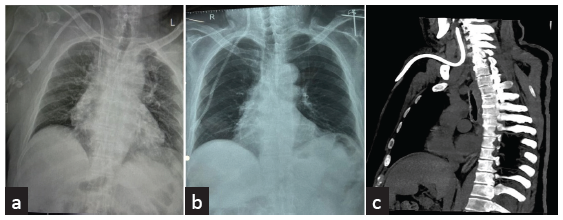Translate this page into:
Spontaneous Intravascular Cephalad Migration of Tunneled Cuffed Catheter – An Unusual Late Complication and Role of Re-Imaging
Corresponding author: Ajay Jaryal, Department of Medicine, AIIMS, Bilaspur, Himachal Pradesh, India. E-mail: drajayjaryal@gmail.com
-
Received: ,
Accepted: ,
How to cite this article: Jaryal A, Vikrant S, Bansal V, Akanksha, Sharma S, Aneja R. Spontaneous Intravascular Cephalad Migration of Tunneled Cuffed Catheter – An Unusual Late Complication and Role of Re-Imaging. Indian J Nephrol. 2025;35:110-1. doi: 10.25259/IJN_264_2024
Tunneled cuffed catheter (TCC) is an important mode of vascular access for hemodialysis (HD) and is notable for high success rate, safety and immediate usability for HD. Beside immediate complications of insertion like mispositioning, failure to function, hemothorax, pneumothorax, prolonged exit site bleeding, surgical site infections, cardiovascular arrythmia and collapse, the commonly encountered delayed complications of TCC are: blockage, slippage, thrombosis, central venous stenosis, stuck catheter during removal, catheter exit-site and catheter-related blood stream infections.1,2 It is unusual for catheter to migrate spontaneously late after insertion. A 71-year-old obese male with diagnosis of type 2 diabetes mellitus, hypertension, obstructive sleep apnea was initiated on HD with a TCC due to complications of end stage renal disease. Appropriate patient consent was obtained. TCC was inserted under real-time USG guidance with no procedure related complications, normal catheter position [Figure 1a] and adequate blood flow for dialysis was achieved with normal inflow and outflow. The patient continued to receive twice-weekly HD until 5 weeks post insertion when outflow from the catheter ceased from both venous and arterial ports, but inflow was normal. A repeat X-ray and later a CT showed the catheter migrated upward into IJV [Figure 1b-c]. The TCC was subsequently removed. Cephalad migration of catheter immediate post insertion has been reported earlier in the literature.3 But delayed migration could be a rarity. Our current case highlights this rare occurrence of delayed cephalad migration of TCC and also the importance of the need of re-imaging whenever encountered with non/poorly functioning TCC.

- (a) Chest X ray showing normal position of TCC after insertion. (b) Chest X ray Showing cephalad migrated TCC. (c) CT Showing cephalad migration of TCC into IJV with tip lying at C2 vertebral level. TCC: Tunneled cuffed catheter, CT: Computerised tomography, IJV: Internal jugular vein, C2: Second cervical vertebra.
Conflicts of interest
There are no conflicts of interest.
References
- POS-578. Short term outcomes of tunneled cuffed catheters- A single center experience. Kidney Int Rep. 2021;6:S254-5.
- [Google Scholar]
- Removal of “stuck tunneled hemodialysis catheter” by hong’s technique: PUB152. J Am Soc Nephrol. 2022;33:926.
- [CrossRef] [PubMed] [Google Scholar]
- Cephalad migration of tunneled-cuffed catheter: The importance of post procedure imaging. Kidney Dial. 2022;2:443-5.
- [Google Scholar]






